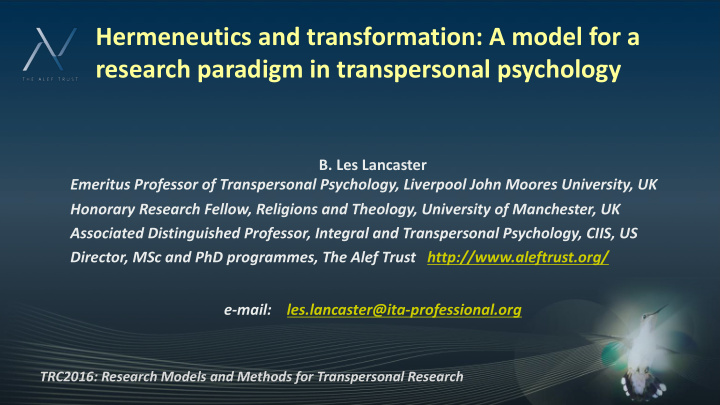



Hermeneutics and transformation: A model for a research paradigm in transpersonal psychology B. Les Lancaster Emeritus Professor of Transpersonal Psychology, Liverpool John Moores University, UK Honorary Research Fellow, Religions and Theology, University of Manchester, UK Associated Distinguished Professor, Integral and Transpersonal Psychology, CIIS, US Director, MSc and PhD programmes, The Alef Trust http://www.aleftrust.org/ e-mail: les.lancaster@ita-professional.org TRC2016: Research Models and Methods for Transpersonal Research
Classifying methods: Agency and transformation • Researcher as integral agent • Research as encountering the Sacred • Research as journey • Research as engaging the ‘unconscious’ Quantitative Qualitative ‘normative’ ‘radical’ ‘dynamic’ psychometric grounded theory heuristic inquiry alchemical hermeneutics • • • • controlled Phenomenology (IPA) organic inquiry intuitive inquiry • • • • experiment hermeneutic • neurophenomenology detached engaged increasing encounter
Classifying methods: Agency and transformation • Researcher as integral agent • Research as encountering the Sacred • Research as journey • Research as engaging the ‘unconscious’ Quantitative Qualitative ‘normative’ ‘radical’ ‘dynamic’ psychometric grounded theory heuristic inquiry alchemical hermeneutics • • • • controlled Phenomenology (IPA) organic inquiry intuitive inquiry • • • • experiment hermeneutic • neurophenomenology secular sacred hermeneutical approach
Midrash as a model for transpersonal methodology There is more in the text than is apparent on the surface; all meaning is in the text • but we have to engage in the Work in order to find it. The method is the Work, the means for encounter. • Levels in the text – surface (‘literal’ / manifest) and deep (‘secret’ / latent). • ‘Intertextuality’ – meaning is neither time-bound nor location-bound in the text. • Driven by questioning the text – how to fill the gaps / resolve inconsistencies etc. • Associative logic (especially re vowel-less Hebrew text) opens possibilities. • Guided by experience and/or other systems for knowing (cf amplification). • “Freud displaced Rabbinic hermeneutics from the text of the Holy Writ to the text of the dream, that is—the speaking psyche of the person.” (Handelman, 1981, p. 202).-
The “faces of God”: An esoteric teaching in the Kabbalah My beloved is white and ruddy, distinguished among ten thousand. His head is like the finest gold, his locks are wavy, and black like a raven. His eyes are like doves by the water courses, washed with milk, and fitly set. Song of Songs 5: 10-12 It is taught: The Book of Concealment is the book describing that which is weighed in the balance; for before there was a balance face did not gaze upon face. Zohar 2:176b The Ancient of Ancients is called the Elongated Face, and the exterior aspect is called the Small Face—small in comparison to the Ancient One, the Elder, Holy of Holy of Holies. When the Small Face gazes upon the Ancient One all below is restored and His face expands and lengthens at that time—but not permanently like the Ancient One. Zohar 3:128b
Original Scriptural text Extra-biblical knowledge Experience of mystics Rabbinical midrash (eg kabbalah / gnosis) authoring the Zohar as imaginal method Relate to their knowledge systems Relate to their experience kabbalistic imagery • engage with their practices • Detail of ‘divine faces’ gnostic systems • understand their context • etc • etc • Hermeneutic Extra-kabbalistic knowledge Experience of the (eg Jungian / neuroscience) ‘wounded’ researcher neurophenomenology Model of ‘deep’ psyche
Recommend
More recommend